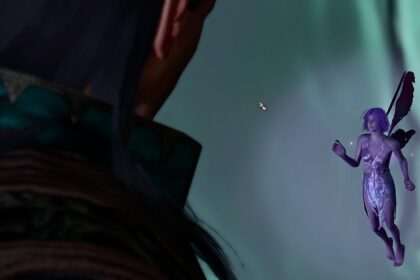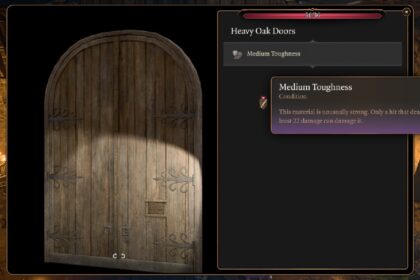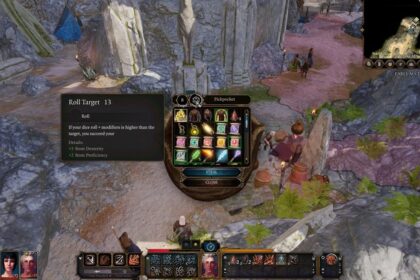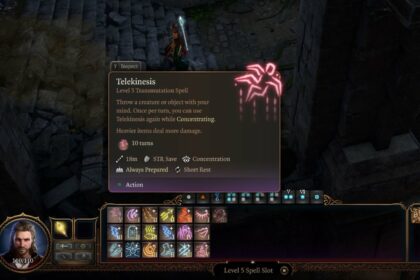While wizards study magic and its ways, sorcerers live it. Magic comes naturally to them, and so comes the power to bend reality at their will.
To represent such powerful concept, Sorcerers can bend spells, changing their shape, number of targets, and speed in which they are cast.
If you want to make the most powerful sorcerer possible in Baldur’s Gate 3, this class guide will certainly help you achieve that goal.
The Sorcerer Class

Sorcerers are natural spellcasters, drawing on inherent magic from a gift, bloodline, or ancestral connection.
Unlike wizards, who pore over spellbooks and scrolls, sorcerers possess an intuitive understanding of magic, allowing them to cast spells without preparation or study.
This innate power stems from their charisma, which serves as their spellcasting ability.
Your spell hit roll, bonus damage when applicable, and Difficult Class for enemies’ saving throw tests are all tied to your Charisma Ability Score.
Class Features
Let’s break down the key features of the sorcerer class:
Hit Points: Sorcerers begin with 6 hit points at 1st level, plus their Constitution modifier. As they level up, they gain an additional 4 hit points plus their Constitution modifier.
Proficiencies: Sorcerers are proficient with daggers, quarterstaffs, and light crossbows. They excel in Constitution and Charisma saving throws. You can choose two skills from a list that includes Arcana, Deception, Insight, Intimidation, Persuasion, and Religion.
Starting Equipment: Sorcerers typically start with a sorcerer robe, simple boots, a quarterstaff, two health potions, and a scroll of revivify.
Spellcasting: Sorcerers are full spellcasters, unlocking a new spell level every two sorcerer levels, up to level 6 spells.
- They begin with four cantrips and gain additional cantrips at levels 5 and 10. The spell save DC is 8 + your proficiency bonus + your Charisma modifier, and your spell attack modifier is your proficiency bonus + your Charisma modifier.
- You know a number of spells equal to 1 plus your Charisma modifier plus your sorcerer level. Sorcerers have a known caster spell list, and they cannot freely change equipped spells except during level-ups.
Sorcery Points: Sorcerers have the unique ability to augment spells with different effects using sorcery points.
Sorcerer Class Progression

Here’s a glimpse of your sorcerer’s journey:
- Level 1: Begin your sorcerer spellcasting and choose a sorcerer subclass (Wild Magic, Draconic Bloodline, Storm Sorcery).
- Level 2: Unlock sorcery points, allowing you to create sorcery points and spell slots as a bonus action. You also choose two metamagic options.
- Level 3: Select an additional metamagic option.
- Level 4: Expand your repertoire with an additional sorcerer cantrip and choose a feat.
- Level 6: Your subclass features become accessible.
- Level 8: Pick another feat.
- Level 10: Add another sorcerer cantrip and an extra metamagic option.
- Level 11: Your subclass features continue to evolve.
- Level 12: Once again, select a feat to enhance your abilities.
Sorcerer Spell Slots
Sorcerers have a unique progression of spell slots as they level up.
Refer to the table below to understand how many sorcery points and cantrips you have at different levels:
| Sorcerer Level | Sorcery Points | Cantrips Known | I | II | III | IV | V | VI |
|---|---|---|---|---|---|---|---|---|
| Level 1 | – | 4 | 2 | – | – | – | – | – |
| Level 2 | 2 | 4 | 3 | – | – | – | – | – |
| Level 3 | 3 | 4 | 4 | 2 | – | – | – | – |
| Level 4 | 4 | 5 | 4 | 3 | – | – | – | – |
| Level 5 | 5 | 5 | 4 | 3 | 2 | – | – | – |
| Level 6 | 6 | 5 | 4 | 3 | 3 | – | – | – |
| Level 7 | 7 | 5 | 4 | 3 | 3 | 1 | – | – |
| Level 8 | 8 | 5 | 4 | 3 | 3 | 2 | – | – |
| Level 9 | 9 | 5 | 4 | 3 | 3 | 3 | 1 | – |
| Level 10 | 10 | 6 | 4 | 3 | 3 | 3 | 2 | – |
| Level 11 | 11 | 6 | 4 | 3 | 3 | 3 | 2 | 1 |
| Level 12 | 12 | 6 | 4 | 3 | 3 | 3 | 2 | 1 |
Sorcerer Tips & Builds
- Draconic Bloodline: Opt for Draconic Bloodline to bolster your armor class and increase elemental damage, focusing on spells like Firebolt for added damage.
- Sorcery Points Management: Convert sorcery points into extra spell slots when needed, allowing for additional spells and maximizing your spellcasting versatility.
- Selecting Spells: Choose spells like Cloud of Daggers for area denial and Magic Missile for reliable damage, contributing effectively in various combat scenarios.
All Sorcerer Spells in Baldur’s Gate 3

Although sorcerers don’t have access to as many spells as wizards do, their list is quite long.
These are the spells that sorcerers have access to. You might want to check what each of these spells do before choosing spells for your sorcerer.
| Sorcerer Cantrips | Sorcerer Level 1 Spells | Sorcerer Level 2 Spells | Sorcerer Level 3 Spells | Sorcerer Level 4 Spells | Sorcerer Level 5 Spells | Sorcerer Level 6 Spells |
|---|---|---|---|---|---|---|
| Blade Ward | Burning Hands | Blindness | Blink | Banishment | Cloudkill | Arcane Gate |
| Acid Splash | Charm Person | Blur | Counterspell | Blight | Cone of Cold | Chain Lightning |
| Mage Hand | Chromatic Orb | Cloud of Daggers | Daylight | Confusion | Dominate Person | Circle of Death |
| Poison Spray | Colour Spray | Crown of Madness | Fear | Dimension Door | Hold Monster | Disintegrate |
| True Strike | Disguise Self | Darkness | Fireball | Greater Invisibility | Insect Plague | Eyebite |
| Friends | Expeditious Retreat | Darkvision | Fly | Ice Storm | Seeming | Globe of Invulnerability |
| Dancing Lights | False Life | Detect Thoughts | Gaseous Form | Polymorph | Telekinesis | Sunbeam |
| Fire Bolt | Feather Fall | Enhance Ability | Haste | Stoneskin | Wall of Stone | – |
| Light | Fog Cloud | Enlarge/Reduce | Hypnotic Pattern | Wall of Fire | – | – |
| Ray of Frost | Ice Knife | Gust of Wind | Lightning Bolt | – | – | – |
| Shocking Grasp | Jump | Hold Person | Protection from Energy | – | – | – |
| Minor Illusion | Mage Armor | Invisibility | Sleet Storm | – | – | – |
| Bone Chill | Magic Missile | Knock | Slow | – | – | – |
| – | Ray of Sickness | Mirror Image | Stinking Cloud | – | – | – |
| – | Shield | Misty Step | – | – | – | – |
| – | Sleep | Phantasmal Force | – | – | – | – |
| – | Thunderwave | Scorching Ray | – | – | – | – |
| – | Witch Bolt | See Invisibility | – | – | – | – |
Sorcerer Metamagic Options
Sorcerers can choose from various metamagic options as they level up. Here’s a list of available metamagic options:
- Careful Spell: Spend sorcery points to protect allies from the effects of your spells.
- Distant Spell: Double the range of your spells.
- Empowered Spell: Reroll damage dice to maximize your damage output.
- Extended Spell: Extend the duration of your spells.
- Heightened Spell: Force enemies to have disadvantage on saving throws against your spells.
- Quickened Spell: Cast a spell as a bonus action, enhancing your spellcasting flexibility.
- Subtle Spell: Cast spells without verbal or somatic components, allowing for stealthy spellcasting.
- Twin Spell: Target two creatures with a single-target spell.
The Wild Magic Subclass

The Wild Magic subclass in Dungeons & Dragons and Baldur’s Gate 3 brings a touch of chaos and unpredictability to the world of sorcery.
It grants sorcerers a unique connection to untamed magic, resulting in thrilling and unforeseeable effects when casting spells of 1st level or higher.
Unpredictable Magic
When a sorcerer of the Wild Magic subclass casts a spell, there’s a chance that a random and unexpected magical effect will accompany the intended spell’s effects.
These additional effects can range from highly beneficial to potentially harmful, creating moments of both wonder and uncertainty in your magical endeavors.
The Wild Magic subclass ensures that no two spells are alike, making your adventures truly unforgettable.
Tides of Chaos
As a Wild Magic Sorcerer, you harness the ancient forces of chaos that churn within you.
This power is epitomized by the Tides of Chaos feature, allowing you to gain advantage on your next attack roll, ability check, or saving throw.
Embrace the chaos and take advantage of this unique ability to turn the tide of fate in your favor.
Wild Magic Features Progression
The Wild Magic subclass in Baldur’s Gate 3 offers a progression of features that embrace the unpredictable nature of your magic:
- Level 1 – Tides of Chaos (Subclass Feature): Activate to gain advantage on your next Attack Roll, Ability Check, or Saving Throw. The chance of triggering a Wild Magic surge increases.
- Level 1 – Wild Magic (Subclass Feature): Unruly magic sparks within you, causing random magical effects when casting spells of 1st level or higher. These effects can be helpful, harmful, or a mix of both.
- Level 6 – Bend Luck (Subclass Feature): Bend Luck allows you to influence the outcomes of attack rolls, ability checks, or saving throws made by creatures you can see. Spend 2 Sorcery Points to roll 1d4 and apply the result as a bonus or penalty to the roll.
- Level 11 – Controlled Chaos (Subclass Feature): Your chaotic aura becomes a hazard to your foes. Nearby spellcasters may experience Wild Magic Surges when casting spells in your presence.
Wild Magic Surge Effects

The Wild Magic surge effects can lead to diverse and intriguing outcomes, including but not limited to:
- Gaining an additional action during your turn.
- Enveloping nearby creatures in a Blur spell, making them harder to hit.
- Setting creatures and objects on fire, causing Fire Damage over time.
- Enlarging or reducing creatures within 30 feet.
- Creating vines to slow or entangle your foes.
- Healing nearby creatures when you hit a target with a spell.
- Temporary flight.
- Creating a blinding fog or obscuring creatures in the vicinity.
- Transforming into a sheep or polymorphing others into cats and dogs.
- Enhancing your armor class and gaining immunity to Magic Missile.
- Slowing yourself.
- Earning Sorcery Points with each spell cast.
- Communicating with animals.
- Creating a hazardous spike growth.
- Summoning Mephits or swapping positions with a target.
- Exercising telekinesis.
- Triggering random magical effects at the start of each turn.
- Summoning a hostile cambion (at higher levels).
Make the Most Out of Bend Luck
Bend Luck offers a unique way to influence the outcomes of others.
When a creature you can see makes an attack roll, ability check, or saving throw, you can spend 2 Sorcery Points to roll 1d4 and apply the result as a bonus or penalty of your choosing to that creature’s roll.
Controlled Chaos: Spreading Unpredictability
Controlled Chaos adds an extra layer of uncertainty to your sorcerer’s presence.
Nearby spellcasters may experience Wild Magic Surges while casting spells in your fluctuating magical aura.
Tips for Wild Magic Sorcerers
- Managing Wild Magic Surges:
- Don’t worry too much about wild magic effects triggering constantly. They don’t happen as often as you might think, so it’s not necessary to focus your entire strategy on mitigating them.
- Tides of Chaos:
- Consider using “Tides of Chaos” to increase the chances of wild magic surges. While the effects can be unpredictable, they can lead to interesting and unexpected outcomes.
- Multiclassing:
- If you’re considering multiclassing, keep in mind that Wild Magic Sorcerers can work well with a few levels in Warlock. It’s a decent combination as long as you don’t take the “Tome” pact.
- Starting as a Sorcerer for Con save proficiency and then taking 3 levels in Warlock with “Repelling Blast” and “Agonizing Blast” invocations can be effective.
- Defensive Spells:
- As a Sorcerer, you have limited spell slots, so choose your defensive spells wisely. Some useful options include “Armor of Agathys,” “Mage Armor” and “Counterspell.”
- Leave some of the defensive spells to other party members if possible.
- Race Considerations:
- If you choose a Dragonborn (fire subclass), the damage from the self-burning wild magic surge will be reduced due to your fire resistance.
- Eldritch Blast vs. Level 6 Spells:
- If you’re contemplating multiclassing into Warlock for Eldritch Blast, consider whether the consistent damage output is more valuable to you than access to level 6 Sorcerer spells. It’s a trade-off, so choose what suits your playstyle best.
- Enjoy the Unpredictability:
- Embrace the chaos and unpredictability of being a Wild Magic Sorcerer. While some surges may seem negative, they can also lead to amusing and memorable moments in the game.
The Draconic Bloodline Subclass

Sorcerers of the Draconic Bloodline exhibit a unique lineage, with their powers derived from the might of dragons.
Draconic Bloodline Features Progression
- Level 1 – Draconic Resilience: Hit Points: Your hit point maximum increases by 1 for each Sorcerer level, enhancing your durability and survivability.
- Level 1 – Draconic Resilience: Armor Class: Your skin is adorned with dragon-like scales, boosting your base Armor Class to 13 when you’re not wearing armor.
- Level 1: Choose Your Dragon Ancestry: At the outset, you must select your dragon ancestry, which defines your elemental affinity and the type of damage associated with your draconic magic.
- Choose from a range of options, including Red (Fire), Black (Acid), Blue (Lightning), White (Cold), Green (Poison), Gold (Fire), Silver (Cold), Bronze (Lightning), Copper (Acid), and Brass (Fire).
- Level 6 – Elemental Affinity: Damage (Subclass Feature): When casting a spell that deals damage aligned with your dragon ancestry, you add your Charisma Modifier to the damage, making your spells more potent.
- Level 6 – Elemental Affinity: Resistance (Subclass Feature): You can spend 1 Sorcery Point to gain Resistance to the damage type associated with your draconic ancestry when casting a relevant spell.
- Level 11 – Fly (Subclass Feature): Unlock the ability to fly to a target position, granting you unmatched mobility in your adventures.
Dragon Ancestry
Each choice of dragon ancestry brings unique benefits to your Draconic Bloodline sorcerer:
- Red (Fire): Spells dealing Fire damage become more potent, and you can become Resistant to Fire Damage. You also automatically learn the burning hands spell.
- Black (Acid): Harness the power of Acid damage, increasing the strength of your spells and your resistance to Acid damage. Additionally, you automatically learn the grease spell.
- Blue (Lightning): Lightning spells become more powerful, and you gain resistance to Lightning damage. You also automatically learn the witch bolt spell.
- White (Cold): Spells inflicting Cold damage gain extra potency, and you can become Resistant to Cold damage. You automatically learn the armor of agathys spell.
- Green (Poison): Poison spells are amplified, and you gain Resistance to Poison damage. Your repertoire expands with the ray of sickness spell.
- Gold (Fire): Further enhance Fire spells, gain Resistance to Fire damage, and automatically learn the disguise self spell.
- Silver (Cold): Amplify spells with Cold damage, gain Cold damage Resistance, and add feather fall to your spell list.
- Bronze (Lightning): Lightning spells become mightier, and you acquire Resistance to Lightning damage. Your spell knowledge includes the fog cloud spell.
- Copper (Acid): Bolster Acid spells, gain Resistance to Acid damage, and add Tasha’s Hideous Laughter to your spells.
- Brass (Fire): Fire spells reach their full potential, you gain Fire damage Resistance, and automatically learn the sleep spell.
Tips and Builds for Draconic Bloodline
To make the most of your Draconic Bloodline sorcerer, consider these tips and observations that will surely help you make the most out of your Draconic Sorcerer:
- Fire Affinity (Red, Brass, Gold): Fire spells are common and powerful, making this a solid choice for a blaster sorcerer. However, be prepared to face more fire-resistant enemies.
- Lightning Affinity (Bronze, Blue): Lightning spells offer versatility and fewer resistances compared to fire. Lightning Bolt and Chain Lightning can be powerful additions to your spell arsenal.
- Cold Affinity (Silver, White): While cold spells are less common, choosing White as your ancestor provides access to Armor of Agathys, a great defensive spell. Keep in mind that cold damage spells are scarcer than fire and lightning.
- Consider Elemental Adept: If you’re concerned about enemy resistances, the Elemental Adept feat can help you ignore resistances to your chosen elemental damage type.
- Remember your resistences: At level 6, you gain a reaction to gain resistance to your dragon’s damage type. Use this strategically to protect against your own spells.
- Spell recommendations: Fireball, Haste, and Fly are always strong choices for utility and damage output.
- Use Magic Items: For instance, you can combine items that increase cold spell damage with your White Dragon’s cold damage boost for powerful Ray of Frost cantrips.
Storm Sorcery Subclass

Storm Sorcerers in Baldur’s Gate 3 wield the power of tempests and elemental forces, commanding the fury of storms.
This subclass offers unique features that enhance your spellcasting abilities and provide a thematic connection to the wing and thunder elements.
Storm Sorcery Features Progression
As a Storm Sorcerer, you’ll gain various features that are unique to this subclass as you level up. Here’s a breakdown of these features:
- Level 1 – Tempestuous Magic: allows you to take to the skies with ease.
- After casting a 1st-level spell or higher, you can use a bonus action to fly until the end of your turn without provoking Opportunity Attacks.
- This feature is not limited to combat and can be triggered by ritual spells that do not consume spell slots.
- Level 6 – Heart of the Storm: This feature makes your storm-themed abilities stronger.
- Heart of the Storm: When you cast a spell of 1st level or higher that deals Lightning or Thunder damage, you create a small local storm.
- All enemies within 6 meters of you take 3 Lightning damage or 3 Thunder damage.
- The damage is based on half your Sorcerer level, not your Character level.
- Heart of the Storm: Resistance: You become resistant to Lightning and Thunder damage, reducing the damage you take from these sources.
- Heart of the Storm: When you cast a spell of 1st level or higher that deals Lightning or Thunder damage, you create a small local storm.
- Level 6 – Extra Spells: You learn the following spells: Learn Call Lightning, Sleet Storm, Gust of Wind, Create or Destroy Water, and Thunderwave
- Level 11 – Storm’s Fury: When you are hit by a melee attack, you deal Lightning damage to the attacker equal to your level.
- After taken damage, there’s a chance the enemy will be pushed away.
- Since the damage taken by the enemy is equal to your Sorcerer level, the minimum damage this feature deals is 11, which is a decent amount of damage.
Create or Destroy Water (Level 1 Spell)
With Create or Destroy Water, you can call forth rain or destroy water-based objects or substances.
It’s a transmutation spell that doesn’t require concentration. When upcast with a 2nd level spell slot or higher, the radius increases.
Thunderwave (Level 1 Spell)
Thunderwave releases a wave of thunderous force that pushes away all creatures and objects. It’s an evocation spell with a range of 5 meters in a cone shape.
Targets that succeed on a Constitution saving throw take half damage. When upcast with higher-level spell slots, it deals additional Thunder damage.
Gust of Wind (Level 2 Spell)
Gust of Wind enables you to summon a strong wind that clears all clouds and pushes creatures back 5 meters, forcing them off balance.
This is an evocation spell that doesn’t require concentration.
Call Lightning (Level 3 Spell)
Call Lightning allows you to summon a bolt of lightning that strikes all targets within range. For the next 10 turns, you can call down lightning again without expending a spell slot.
This spell deals Lightning damage and is a conjuration spell that requires concentration.
Sleet Storm (Level 3 Spell)
Sleet Storm lets you call forth a storm that disrupts the concentration of spellcasters, douses fires, and creates an ice surface. It’s a conjuration spell that requires concentration.
Tips for Storm Sorcerers
- Use Tempestuous Magic to Control Position: Your Tempestuous Magic ability allows you to fly away after casting a spell.
- Use this to your advantage by positioning yourself strategically.
- Fly into dangerous positions to bait enemies or get a better line of sight for your spells, and then quickly retreat to safety.
- Focus on Control Spells: Storm Sorcerers aren’t pure damage dealers like Draconic Sorcerers.
- You have the potential to manipulate the battlefield.
- Consider using spells like Thunderwave or Cloud of Daggers to control enemy positions and protect your allies.
- Take Advantage of Your Flight: Your ability to fly at will is a significant advantage.
- It allows you to reposition yourself, avoid obstacles, and remain safe from opportunity attacks.
- Remember that you can also use spells like Misty Step alongside your flight for added mobility.
- Consider Your Race: Depending on your campaign and character concept, choose a race that complements your Storm Sorcerer abilities.
- Races like Half-Elf can give you access to light armor and shields, increasing your survivability when you’re not flying.
- Elemental Spell Selection: Focus on spells that deal Lightning and Thunder damage to synergize with your subclass.
- Lightning Bolt, Chain Lightning, and Thunderwave are excellent choices.
- Elemental Adept (Lightning and Thunder) feat can help you overcome resistances.
- Control the Battlefield: Use spells like Gust of Wind or Sleet Storm to manipulate the battlefield.
- These spells create difficult terrain or obscure vision, making it harder for enemies to approach or target you.
- Beware of Resource Management: Keep an eye on your spell slots and sorcery points.
- While Storm Sorcerers don’t use sorcery points for their class features, they are still a valuable resource for Metamagic.
- Plan your spellcasting and metamagic use wisely.
- Multiclassing Options: Consider a multiclass into Tempest Cleric for two levels to gain heavy armor, shields, martial weapons, and the ability to maximize Thunder or Lightning damage once per short rest.
- Embrace Your Elemental Theme: Lean into your Storm Sorcerer’s elemental theme. Utilize Lightning and Thunder spells whenever possible to maximize your subclass features’ effectiveness.
- Stay Safe: As a Storm Sorcerer, you have limited defensive capabilities.
- Stay in the backline whenever possible and prioritize your own safety.
- Your ability to control position and fly away should help you stay out of harm’s way.
Sorcerer Multiclass Options

There are many ways to multiclass with Sorcerers. They are especially good when combined with Bard and Warlock levels since all of them share the same Spellcasting Ability: Charisma.
That said, we are going to provide a complex multiclass build and a few level dipping options in this class.
For a more complex multiclass, check our Warlock class guide or see how Wild Magic Sorcerers can actually work great with a few Barbarian levels.
Sorcerer 6 / Tempest Cleric 2 / Evocation Wizard 2
- Mechanical Synergy: This multiclass build capitalizes on a synergistic blend of lightning and thunder damage, enhanced spellcasting, and battlefield control.
- Beginning as a Sorcerer offers Constitution proficiency, adding durability to your character.
- The subsequent 2 levels as a Tempest Cleric unlock the potent Destructive Wrath feature, which supercharges your lightning and thunder spells, making them more devastating.
- Further progression in Sorcerer to level 5 grants access to Heart of the Storm, providing additional damage boosts.
- The final step involves dipping into Evocation Wizard for 2 levels, granting access to the Sculpt Spells feature.
- How It Works: Your Sorcerer levels offer a pool of spell slots and access to sorcery points, which are essential for Metamagic.
- Destructive Wrath from Tempest Cleric ensures your lightning and thunder spells deal maximum damage when needed.
- Sculpt Spells from Evocation Wizard allows you to cast area of effect (AoE) spells while safeguarding your allies from harm.
- Pros:
- Damage Maximization: Heart of the Storm, Destructive Wrath, and your lightning charge items synergize to maximize damage output.
- Protective AoE: Sculpt Spells lets you cast AoE spells without harming your allies, enhancing battlefield control.
- Cons:
- Delayed Progression: Multiclassing delays the acquisition of higher-level spells.
- Evocation Spells Only: Sculpt Spells benefits apply only to Evocation spells.
Sorcerer 10 / Tempest Cleric 2
- Mechanical Synergy: This build harmonizes Sorcerer’s spellcasting prowess with the enhanced capabilities of Tempest Cleric.
- How It Works: You focus on advancing as a Sorcerer to reach level 10, which grants access to 5th-level spells. Meanwhile, your 2 levels in Tempest Cleric bestow Destructive Wrath, amplifying the damage of your lightning and thunder spells.
- Pros:
- Powerful Spellcasting: Access to 5th-level spells empowers your spell repertoire.
- Damage Boost: Destructive Wrath ensures your lightning and thunder spells hit harder.
- Cons:
- Delayed Progression: Multiclassing postpones the attainment of higher-level spells.
- Lack of Sculpt Spells: You miss out on the Evocation Wizard’s Sculpt Spells feature.
Sorcerer 9 / Tempest Cleric 2 / Wizard 1
- Mechanical Synergy: This build synthesizes Sorcerer’s magic with the strength of Tempest Cleric while adding utility spells from Wizard.
- How It Works: Your journey begins as a Sorcerer, eventually reaching level 9 for access to 5th-level spells.
- Along the way, you acquire 2 levels in Tempest Cleric to benefit from Destructive Wrath.
- A 1-level dip into Wizard enhances your spellcasting utility by allowing you to scribe higher-level spells into your spellbook.
- Pros:
- Versatile Spellcasting: Access to 5th-level Sorcerer spells and Cleric damage boosts.
- Spell Variety: Wizard levels offer a diverse spell selection, augmenting your capabilities.
- Destructive Power: Destructive Wrath enhances your lightning and thunder spells.
- Cons:
- Delayed Progression: Multiclassing delays access to higher-level spells.
- Attribute Split: You need to allocate attribute points to Charisma, Wisdom, and Intelligence.
Sorcerer 10 / Warlock 2 or Wizard 1
- Mechanical Synergy: This build combines the raw power of Sorcerer with the versatility of either Warlock or Wizard.
- How It Works: Starting as a Sorcerer, you progress to level 10, gaining access to 5th-level spells.
- The next step involves multiclassing either as a Warlock for 2 levels or a Wizard for 1 level. Choosing Warlock grants access to Eldritch Blast, which can benefit from Metamagic and items.
- Opting for Wizard provides a spellbook and utility spells.
- Pros:
- Potent Spellcasting: Access to 5th-level Sorcerer spells ensures formidable spellcasting.
- Versatility: Warlock levels offer Eldritch Blast with Metamagic synergy, while Wizard levels provide a spellbook and utility spells.
- Cons:
- Delayed Progression: Multiclassing results in a slower acquisition of higher-level spells.
- Theme Divergence: May not fully align with the lightning and thunder theme, depending on the chosen multiclass option.






